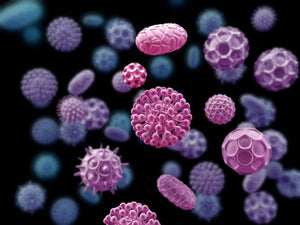Bacteria in Space
March 13, 2017

Imagine being the lone survivor in a space capsule hurdling towards Mars, struggling with the head cold that killed the other astronauts. Your companions took the last of the antibiotics thousands of miles ago, but that does not really matter now – the common bacteria had become resistant to all the antibiotics on board anyway.
Monster bacteria in space sounds like the stuff of science fiction, but real life scientists are finding that some bacteria grow faster, mutate more readily, and can become more infectious or resistant to antibiotics in space than on earth. Before astronauts can venture into deep space, scientists will need to understand how microbes become more of a threat as they get farther from Earth.
Microbes in Space are More Aggressive
Researchers have already found that bacteria are more aggressive aboard the international space station (ISS) than on Earth. They are also finding that some ISS astronauts experience subtle changes in their bacterial composition, which affects the protective mix of microbes in the digestive tract that influences how the immune system protects the body from infections.
“We see they are responding in ways that are completely unexpected,” said Cheryl Nickerson in an interview with the Wall Street Journal. In her role as a microbiologist at Arizona State University’s Biodesign Institute, Nickerson studies how bacteria behave in space. “What are bacteria going to do over a long duration as we get farther and farther from Earth?”
Bacteria in Space is Nothing New
The history of spaceflight is riddled with minor infections. Researchers from the National Aeronautics and Space Administration (NASA) have been studying bacteria in space since the 1960s, when they found Salmonella and E. coli grew at different rates in orbit as they did on earth. In the 1970s, Soviet-era Russian scientists determined that Staphylococcus and other infectious microbes aboard their spacecraft had become increasingly resistant to five common antibiotics. In 2006, a team led by Dr. Nickerson was the first to prove that some bacteria become more lethal in orbit.
Cosmonauts on the Soviet space station Mir frequently suffered from pink eye, acute respiratory illnesses and dental infections, according to a 2015 study in the journal Infection and Drug Resistance. In the 30 years NASA’s space shuttle program, 29 astronauts officially reported fevers, head colds, stomach problems or other types of infections while in orbit. While none of these infections were life-threatening, they were uncomfortable. About 75 percent of all space shuttle crewmembers took medication for minor ailments during their spaceflights.
Bacteria Can Threaten Future Space Missions
To gain a better understanding of how antibiotic-resistant superbugs act in space, NASA plans to perform controlled experiments on the superbug methicillin-resistant staphylococcus aureus (MRSA) on board the ISS. The space organization also plans to launch a satellite carrying E. coli to test how the bacteria reacts to different doses of antibiotics in a weightless environment.
Space medicine experts at NASA, Russia and the European Space Agency worry about pathogens that are relatively harmless here on earth changing in unpredictable ways during long interplanetary voyages or in a facility in space.
“As we look at longer-term missions, we have to know the risks and how to protect the health of these astronauts,” said microbiologist Kasthuri Venkateswaran, who studies the microorganisms found aboard the space station during his work at NASA’s Jet Propulsion Laboratory in Pasadena, California.
Air purifiers, disinfectant wipes and vacuum cleaners keep the space station cleaner than the average home on planet Earth, but there are still 85 different types of bacteria on the ISS, and most of them are resistant to antibiotics.
Dr. Venkateswaran identified bacteria responsible for causing respiratory illness and acne outbreaks in astronauts on the space station. He identified one particular fungus, Aspergillus fumigates, growing on a space station window. On earth, Aspergillus fumigates causes allergic reactions, respiratory illness and bloodstream infections. The big problem was that the mold growing on the window of the space station was more virulent than the same fungus on Earth.
The newest research involving DNA analytics reveals that being weightless affects microbes normally living in the stomach and intestines of the astronauts. In that study of nine astronauts, researchers found that the microbiomes on the astronauts’ skin and digestive tracts changed, although it is not apparent whether these changes affect astronauts’ health.
To learn more about microbial behavior at low gravity, researchers compared E. coli bacteria on the space station and on Earth. The results show cells grow 13 times faster in space and that dozens of E. coli genes become more active in space than on their home planet.
Microbiologists are now exploring countermeasures to help future astronauts identify bacteria in space by using low-cost, high-speed gene sequencing machines and information stored on DNA databases. In August on 2016, space station crewmember Kathleen Rubins became the first person to sequence DNA in orbit, using a cutting-edge handheld device.
With this technology and other advancements, space travelers may someday identify dangerous microbes on board their spacecraft mid-flight, and diagnose their own illnesses with handheld machines as they hurdle through space to destinations unknown.
The post Bacteria in Space appeared first on Natren Probiotics Blog.





Leave a comment